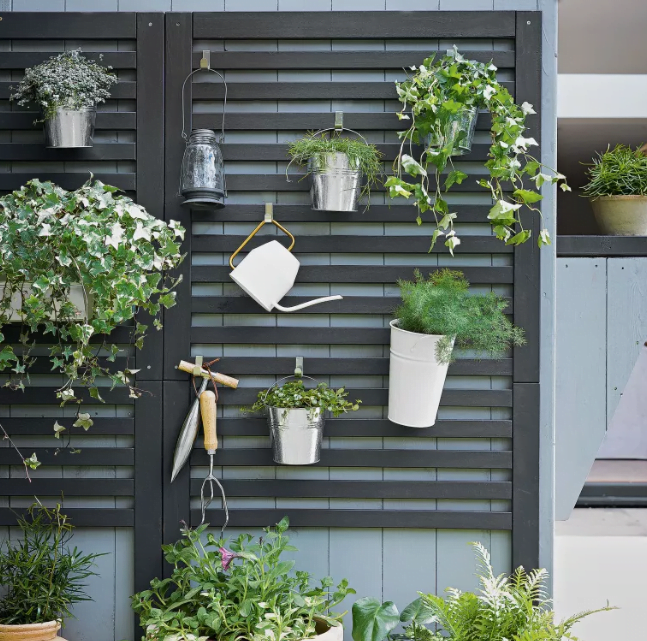
BEAUTIFY YOUR GARDEN: CREATIVE DESIGN AND DECORATION IDEAS
Cultivating garden splendour
When it comes to garden design, there are no limits to creativity. Elevating your garden from ordinary to extraordinary requires innovative design and thoughtful decoration. By discovering unique ideas that harmonise with nature, you can transform your outdoor space into a sanctuary of beauty and tranquillity.
READ ALSO :
15 INCREDIBLE SMALL GARDEN DESIGN IDEAS TO RECREATE
DIY GARDENING HACKS: IDEAS TO TRANSFORM YOUR BACKYARD
10 FABULOUS GARDEN DECORATION IDEAS WITH ROCKS AND STONES
1. Get an idea of the identity of your garden.
Start by imagining the personality of your garden. Is it a flowering paradise or a tranquil Zen retreat? Defining this identity will set the tone for your design decisions and guide your choice of plants, colours and decoration.
2. the power of native flora
Incorporate native plants into your garden design. Not only do they thrive in your local environment, but they also attract native wildlife, promote a balanced ecosystem and add natural charm to your garden.
3. creative plant arrangements
4. functional garden art
Incorporate functional works of art into your garden. Think ornate trellises, wind chimes or garden sculptures. These not only serve a purpose, but also add a touch of elegance and whimsy to your garden.
5. lighting magic
Harness the magic of outdoor lighting. Attach fairy lights in the trees, place solar-powered lanterns along pathways and install subtle spotlights to highlight specific points. The lighting will transform your garden into an enchanting realm after sunset.
6. water features: Serenity in motion
Consider a water feature such as a fountain, pond or stream. The gentle sound of running water relaxes the mind and creates a serene atmosphere. Combine water features with strategically placed stones and plants to create a harmonious natural environment.
7. DIY garden furniture
Craft your garden furniture from recycled materials. Sofas made from pallets, mosaic tables and hanging chairs add a personal touch to the garden. Make yourself comfortable without compromising on style and increase the functionality and appeal of your garden
Experiment with different plant arrangements. Combine textures, colours and heights to create visual interest. Consider vertical gardening or raised beds to maximise space and add depth to your garden.
Plan Your Garden Design:
Before you start embellishing, have an unmistakable arrangement for your Garden design. Settle on regions for seating, pathways, bloom beds, and a particular elements you need to incorporate.
Arranging your Garden format is the essential move toward making a lovely and practical open air space. This is the way to move toward it:
Survey Your Space:
Investigate your garden region. Note its aspects, any current highlights like trees, bushes, or designs, and consider factors like daylight openness and wind course.
Decide Garden Zones:
Conclude how you need to utilize your garden. Do you need a seating region, a play zone for youngsters, space for cultivating, or a blend? Characterize particular zones in view of your inclinations and necessities.
Think about Stream and Openness:
Ponder how individuals will travel through your nursery. Make pathways that associate various regions and guarantee simple openness. A very much arranged stream forestalls a jumbled and confused appearance.
Represent Daylight and Shade:
Comprehend where the sun and shade fall at various times. This information will assist you with choosing where to put sun-cherishing plants and where to make concealed seating regions.
Focus on Central Focuses:
Distinguish central focuses like existing trees, fascinating arranging highlights, or central plants. Plan your design to cause to notice these focuses, improving the visual allure of your nursery.
Contemplate Perspectives:
Consider what you’ll see from various points inside and outside your nursery. Ensure your format exploits satisfying perspectives while perhaps hindering less helpful ones.
Sketch a Harsh Plan:
Begin by outlining a harsh format on paper. Utilize basic shapes to address various zones, pathways, and significant elements. This will give you a visual manual for work with.
Research Plant Similarity:
On the off chance that you’re arranging a nursery with plants, research which plants flourish in your environment, soil type, and daylight conditions. This will impact where you place different plant beds.
Represent Seasons:
Recall that your nursery will develop all through the seasons. Consider how your design will look and work during changed seasons.
Remain Adaptable:
While arranging is fundamental, stay adaptable. You could find groundbreaking thoughts or face unforeseen difficulties as you begin executing your arrangement.
Keep in mind, your nursery format makes way for all the plan components to come. Getting some margin to design mindfully guarantees that your nursery will be both stylishly satisfying and utilitarian.
🎯 Discover Your Home Decor Style
7. Make Practical Zones:
Partition your garden into practical zones in light of how you mean to utilize the space. Think about regions for feasting, relaxing, cultivating, and, surprisingly, a play region for youngsters if material.
Making utilitarian zones inside your nursery adds reason and upgrades the convenience of your open air space. This is the way to plan particular regions that take care of various exercises:
1. Outside Eating Region:
Assign a zone for outside eating. Place a table and seats in a concealed or to some extent concealed region. Consider adding an umbrella for sun security. This zone is ideally suited for feasts, social affairs, and partaking in the natural air.
2. Unwinding Zone:
Make an agreeable region for unwinding. Utilize comfortable outside couches, relax seats, and loungers. Organize this zone in a peaceful piece of your nursery where you can loosen up, read, or basically appreciate nature.
3. Play Zone for Youngsters:
In the event that you have kids, set up a play region with swings, a sandbox, or other age-proper play hardware. This zone ought to be securely away from possible risks and close enough for you to administer.
4. Cultivating and Establishing Region:
Plan a space for cultivating exercises. This could incorporate raised beds, preparing seats, and capacity for planting apparatuses. Having a devoted region for planting and watching out for your plants keeps everything coordinated.
5. Reflection or Yoga Space:
In the event that you’re leaned towards health rehearses, make a quiet corner for contemplation or yoga. Utilize delicate pads, mats, and maybe a little water component to cultivate quietness.
6. Diversion Zone:
On the off chance that you appreciate facilitating social affairs, set up a diversion zone with seating and maybe an outside bar or grill region. Consider adding a fire pit or outside radiator for cold nights.
7. Untamed life Fascination Zone:
Assign a corner to draw in and notice untamed life. Place bird feeders, water basins, and local plants to energize birds, butterflies, and different animals to visit your nursery.
8. Understanding Alcove:
Set up a comfortable perusing niche with an agreeable seat, a side table for books and drinks, and maybe a delicate cover. This tranquil spot can turn into your break for relaxed understanding meetings.
9. Spice or Vegetable Nursery:
Dispense a piece of your nursery for developing spices, vegetables, or natural products. Raised beds or holders function admirably for this reason. Having your own new produce adds usefulness to your nursery.
10. Craftsmanship and Show Zone:
Make a region to show garden craftsmanship, figures, or enriching components. Place them decisively to get the attention and add creative energy to your nursery.
11. Pathways and Course:
Configuration clear pathways that interface the various zones. These ways ought to direct development through the nursery, keeping it coordinated and open.
12. Adaptability and Versatility:
Remember that your practical zones can be adaptable and versatile. For example, your unwinding zone could serve as a diversion region during social events. Contemplate how these zones can fill various needs.
By creating functional zones, you’ll be able to optimize your garden’s potential and cater to various activities that enrich your outdoor experience. Each zone contributes to the overall harmony and functionality of your garden oasis.Creating functional zones within your garden adds purpose and enhances the usability of your outdoor space. Here’s how to design distinct areas that cater to different activities:
3. Pick a Topic or Style:
Select a topic or style that mirrors your character and inclinations. Whether it’s a comfortable cabin garden, a smooth current desert spring, or a lively tropical heaven, having a subject will direct your plan choices.
8. Consolidate Open air Seating:
Put resources into agreeable and upscale open air furniture. Consider choices like climate safe couches, seats, and seats that give a comfortable spot to unwind and partake in your nursery.
9. Upgrade with Lighting:
Enlighten your nursery with different kinds of lighting. String lights, lamps, and sun based controlled way lights can make an otherworldly climate during nights and evenings.
10. Incorporate Water Elements:
Water highlights like wellsprings, lakes, or flowing cascades can add a relieving and peaceful component to your nursery. The sound of running water can inconceivably quiet.
11. Plant Different Vegetation:
Select different plants that flourish in your environment and daylight conditions. Blend various kinds of blossoms, bushes, and trees to make visual interest and give environment to neighborhood natural life.
12. Consolidate Vertical Nurseries:
Vertical gardens or living walls can save space and add an extraordinary aspect to your nursery. Use lattices, grower, or hanging containers to in an upward direction develop plants.
13. Add Bright Pronunciations:
Implant lively varieties into your nursery through bright pots, grower, pads, and outside carpets. Select tones that supplement your picked subject and the encompassing plant life.
14. Introduce Nursery Workmanship and Models:
Consolidate workmanship and models to add a hint of tastefulness and character to your nursery. These pieces can become central focuses and ice breakers.
15. Configuration Nursery Pathways:
Make welcoming pathways that guide guests through your nursery. You can utilize materials like rock, venturing stones, or even recovered wood to build these pathways.
16. Incorporate Perky Components:
In the event that you have kids, consider consolidating perky components like a swing set, a treehouse, or a sandbox to make your nursery a tomfoolery and family-accommodating space.
17. Embrace Normal Components:
Utilize normal materials like rocks, stones, and driftwood to improve the natural appeal of your nursery. These components can mix flawlessly with your plantings.
18. Draw in Untamed life:
Coordinate bird feeders, water basins, and local plants to draw in birds, butterflies, and other untamed life. This can add to the biodiversity and exuberance of your nursery.
19. Customize with Do-It-Yourself Tasks:
Mix your nursery with individual contacts through Do-It-Yourself projects. Make painted plant markers, hand-painted pots, or even form a little wooden spice garden.
By carrying out these innovative plan and beautification thoughts, your nursery can develop into a delightful and amicable open air space where you can unwind, engage, and interface with nature.

